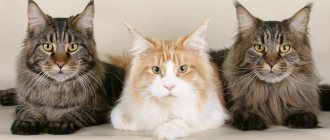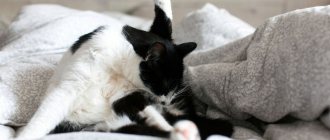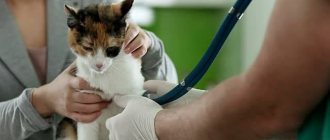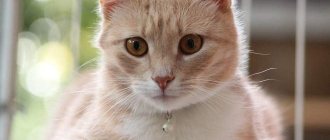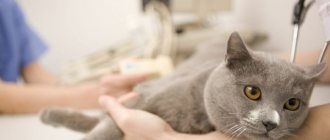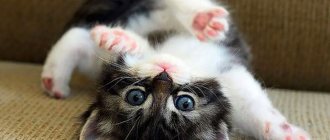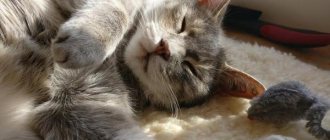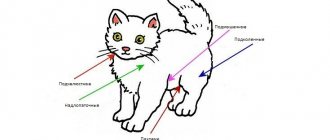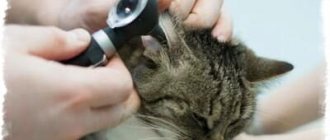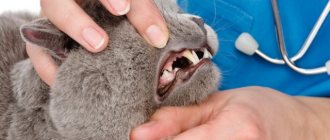What is pneumonia
Pneumonia is an inflammation of the lung parenchyma, i.e. functional tissue responsible for the process of gas exchange in the body. The second name of the disease is pneumonia. Pathology can lead to the development of hypoxia, cough, shortness of breath, and in advanced cases, pulmonary edema is possible.
In addition, there are other dangerous features of pneumonia. The walls of the pulmonary alveoli are literally penetrated by thousands of blood vessels, due to which normal gas exchange occurs. When inflammatory exudate accumulates in the lungs, the substances it contains are absorbed into the blood. It is for this reason that pneumonia is accompanied by a severe deterioration in the general condition of both animals and people.
Diagnostics: tests, x-rays and bronchoscopy
Diagnosis of pneumonia begins with a visual examination of the cat, measuring body temperature, and listening to the sternum area with a phonendoscope for the presence of wheezing. The veterinarian will definitely take a general blood test to determine the level of leukocytes (during inflammatory processes in the body, their level is usually higher than normal).
One of the effective methods for diagnosing pneumonia in a cat is radiographic examination, which is a method of dynamic examination using x-rays. In real time, using this device, the veterinarian is able to monitor the condition of the animal’s internal organs and select the most suitable projection for the image in order to determine the presence or absence of inflamed elements in the lungs.
In cases where the results of radiographic examination are in doubt, veterinary medicine resorts to bronchoscopy. This is the introduction of a thin bronchoscope into the trachea and bronchi for direct examination and a more detailed examination of their condition. This type of diagnosis can also be used to perform a biopsy for further histological examination and removal of foreign bodies (if necessary).
Types of pneumonia
Experts identify the following types of pneumonia:
- Focal type. The simplest and most common option. Only small, isolated areas of the lungs become inflamed. As a rule, these are areas adjacent to large bronchi.
- Segmental variety. A small educational program: a segment is a part of a lung lobe. Accordingly, in this case a separate segment becomes inflamed. As a rule, it is also adjacent to the large bronchi through which the infection has spread.
- Lobar pneumonia. The whole lobe becomes inflamed. One of the heaviest varieties.
- Drain type. This is the name of a type of pathology when lesions of several segments or lobes merge.
- Total, or generalized variety. Inflammation covers the entire lungs.
Separately, we need to dwell on the last variety. As you know, the lungs are a paired organ, and therefore the total type can be either unilateral or bilateral. Lobar or segmental lesions may also be found in both lungs.
Causes of pneumonia in cats
The following reasons for the development of pneumonia in cats are identified:
- Severe hypothermia. Even if your pet lives in a rural area, you should not let him go for a walk if it is too cold outside.
- Sudden temperature changes. It is extremely dangerous for cats to move from an air-conditioned room to the outdoors in the summer heat.
- Advanced bronchitis. If no one has properly treated the cat, the infection will definitely go down the bronchial tree (we have already indirectly mentioned this in the part on the classification of inflammation).
- Severe dust, smoke or gas contamination in the premises. The simplest example is that if a full-scale renovation is being done in an apartment, it is better to “float” the cat somewhere for this period.
- Infectious diseases , one way or another accompanied by damage to the respiratory system.
- Helminthic infestations . This is due to the fact that parasite larvae migrate from the cat’s intestines to the lungs. The digestive system of the parasites themselves is full of intestinal microflora. When the latter enters the delicate lung tissue, severe inflammation inevitably develops. In addition, in some cases, adult helminths may enter the lungs (through vomiting, for example).
- Pneumonia of aspiration type. It happens when, with severe vomiting or contraction of smooth muscles during anesthesia, semi-digested food masses and gastric juice enter the pulmonary alveoli. This variety is extremely difficult and very often ends in the death of the animal.
Danger of pneumonia
Detection of the disease too late can result in damage to most of the lung tissue. This has a detrimental effect not only on the respiratory system, but also on other related organs that fight infectious intoxication.
At-risk groups
The risk group consists of animals deprived of a balanced diet and comfortable living conditions. These include:
- shelter residents living in small, cold spaces with poor ventilation;
- homeless cats forced to fight daily for food and find a roof over their heads;
- pets weakened by chronic diseases or frequent helminthiases.
The age factor should also be taken into account. The weakest immunity is typical for premature kittens and older pets.
Complications
If signs and symptoms of pneumonia appear in a cat, treatment should not be delayed. Diagnosis in late stages leads to an unfavorable prognosis. Prolonged development of the disease is fraught with chronicity of the process, pulmonary edema and blood poisoning.
The kidneys and liver suffer greatly from intoxication. All these changes are a huge burden on the body of a furry pet. With severe damage to the lung tissue, death is inevitable.
Acute and chronic form
And again returning to the topic of classification of pneumonia. If we talk about the type of inflammatory process, there are acute and chronic forms.
Let's look at the differences between these types:
- The most common is acute inflammation. It develops quickly (within a few days at most), accompanied by the appearance of pronounced symptoms. In particular, a sick cat instantly loses its appetite, its body temperature rises, and the pet becomes lethargic and apathetic.
- The chronic form of pneumonia in almost 100% of cases is a consequence of incompletely cured acute inflammation. If pockets of infection remain in the lungs, they may smolder sluggishly. The chronic type manifests itself in the form of episodic relapses, which are especially likely in the fall and spring, i.e. during the wettest and coolest times of the year.
Diagnostics
To identify the disease, the doctor examines the pet and asks the owners for complaints. To identify pneumonia, a physical examination is performed and a referral is given to the laboratory and to the instrumental diagnostic room.
The animal is prescribed:
- auscultation - listening to the lungs;
- taking blood tests;
- radiography or ultrasound.
Based on the results of the examination, an accurate diagnosis is made, indicating the type of pneumonia and the extent of the pathological process. Next, the doctor decides whether to hospitalize or prescribe outpatient treatment.
Symptoms and first signs of the disease
Pneumonia is characterized by the following symptoms and first signs of the disease:
- Cough. In many cases it is initially hard and barky, but subsequently softens to become moist. At the same time, wheezing and gurgling appear in the chest.
- Spontaneous and sharp increase in general body temperature. A fever of a constant or intermittent type is considered typical; temperature “swings” are often observed when the animal alternately becomes hot and then noticeably “cold.” This has an extremely bad effect on the state of the vascular system and old/very young animals can die already at this stage.
- Shortness of breath, hoarse and difficult breathing. Sometimes the cat begins to whistle and snore, reminiscent of a boiling kettle. In severe cases, breathing becomes so difficult that all visible mucous membranes turn blue. In such situations, by the way, it is necessary to urgently call the veterinarian: such severe hypoxia is extremely dangerous and rarely goes away without serious consequences (including for the brain).
- There may be visible enlargement of the subcutaneous lymph nodes.
- The animal refuses food. Thirst, as a rule, either remains at the same level or intensifies.
Diagnosis of inflammation in a clinical setting
In practice, owners and veterinarians are often faced with a typical problem: despite the severity and brightness of the symptoms, it is impossible to make a diagnosis based on the clinical picture alone. A serious diagnosis of inflammation in a clinical setting is necessary:
- First, the specialist will carefully examine the animal and collect a detailed history (when the cat got sick, what preceded it, etc.).
- If pneumonia or other diseases of the respiratory system are suspected, listening to the chest using a phonendoscope will always be a mandatory diagnostic step. A competent specialist will already be able to determine the source of inflammation and its area at this stage.
- Chest percussion (tapping) may also be used. Again, for an experienced veterinarian, the method can provide a lot of valuable information about the location and size of the inflammatory focus. But! When it is located deep in the pulmonary lobes, beyond the reach of percussion, this technique gives results of dubious value.
- But still, the main diagnostic methods are fluoroscopy and ultrasound examination of the chest.
Prevention of pneumonia, favorable conditions after hospitalization
If the diagnosis of pneumonia is confirmed, your pet will most likely be hospitalized for several days. Treatment includes antibiotics, penicillin or amoxicillin, and diuretics to clear accumulated fluid in the airways.
After discharge, prepare a bright, ventilated room for the cat. Always heat food and water until warm. A proper diet rich in vitamins and minerals is the key to health! Bring the food to a liquid pulp, so it will be more convenient for the cat to eat. If Fluffy refuses to eat, try his favorite canned food.
Keep your cat warm, isolating him from other pets, so as not to unnecessarily irritate your pet. Do everything to ensure that he gets as much rest and sleep as possible.
Regularly visit a veterinary clinic for preventive examinations, consult with a doctor and revaccinate.
Sign up for treatment for pneumonia
POLAR BEAR
The veterinary clinic in Nizhny Novgorod "White Bear" provides all types of services for cats and dogs.
Conducts any examinations and tests in its own veterinary laboratory; the clinic operates a veterinary ambulance for animals and a 24-hour veterinarian is on call at home. Agreement on the processing of personal data
Public offer
SITE MENU
- About the clinic
- Price list for veterinary clinic services
- Treatment
- Services
- Price list for veterinary clinic services
- Vetapteka
- Contacts
- Site Map
CONTACTS
- Nizhny Novgorod st. Vyatskaya 7
- 8 (831) 437-25-27
- [email protected]
How to prepare a cat for an x-ray
There is absolutely nothing complicated about how to prepare a cat for an x-ray:
- It is highly advisable to keep your pet hungry before x-rays. The fact is that in some cases general anesthesia (anesthesia) may be required, since during the examination the animal must be absolutely calm. Without anesthetic drugs, this can be difficult or even impossible to achieve. The problem is that during anesthesia the peristalsis of smooth muscles changes. If there are food masses in the stomach, vomiting will occur. And vomit will almost certainly end up in the lungs, which further contributes to the development of aspiration pneumonia. To avoid this, the animal is not fed five hours before the procedure, and water is not given two hours before the test.
- Antitussives may be needed to suppress the cough reflex. Only a veterinarian prescribes them, since these drugs are not always needed!
Briefly about the main thing
Instead of output:
- Bronchitis most often occurs in pets with weakened immune systems (for example, vitamin deficiency) and in older animals;
- Cough (vomiting), nasal discharge, lethargy are the main signs of bronchitis, if they occur, contact your veterinarian immediately;
- The sooner you start treatment, the faster your pet’s body will recover and the greater complications will be avoided (for example, bronchial asthma);
- Prevention of bronchitis is to prevent the animal from hypothermia: do not let the cat sleep on a cold tile, do not open windows for a long time in winter, always put warm water on;
- Diagnosis and treatment of bronchitis in cats is possible only in a veterinary clinic - always trust the health of your furry pet to professionals.
Treatment of pneumonia in cats
In most cases, treatment of pneumonia in cats is carried out as follows:
- First, the effects of intoxication and dehydration are eliminated. To do this, detoxification solutions and glucose are administered intravenously, preventing the development of exhaustion.
- When treating pneumonia, broad-spectrum antibiotics are used in 100% of cases.
- Veterinarians sometimes prescribe anti-inflammatory corticosteroids.
- To speed up the removal of sputum from the pulmonary alveoli, mucolytic and expectorant drugs are used.
- Sometimes autohemotherapy is prescribed (when the cat's own blood is injected intramuscularly).
- Multivitamin preparations promote recovery.
- If the cat has severe hypoxia, oxygen therapy is prescribed.
Why do cats develop bronchitis?
A common cause of bronchitis in cats is hypothermia. Usually it occurs not due to the fact that animals spend a long time in the cold, but due to getting wet or drafts (for example, with frequent bathing or open windows in the cold season).
On a note! Hypothermia occurs if you give your cat cold water or food (for example, frozen fish).
Other causes of bronchitis in cats:
- Allergies . One form of bronchitis is allergic. This is the animal’s body’s response to the action of various allergens. Most often they are tobacco smoke, pollen, household chemicals and other substances;
- Infections . Infectious disease agents (fungi, viruses, bacteria) weaken pets’ immunity and have an irritating effect on the bronchial mucosa. As a result, not only a focus of inflammation develops, but also a cough reflex due to the narrowing of the lumen of the bronchi;
- Non-food poisoning . We are talking about poisoning an animal with pesticides (for example, from insects or rodents), caustic gas vapors or household chemicals. When they are inhaled, irritants enter the bronchial mucosa, causing swelling and inflammation;
- Tracheal collapse . A genetically determined degenerative disease in which flattening of the tracheal rings is observed. Against the background of tracheal collapse, irritation of the receptors occurs and a cough occurs;
- Other reasons . These include helminthic infestations in the absence of effective treatment, complications after severe cardiovascular diseases in a pet, and neoplasia (tumors). Separately, idiopathic bronchitis is distinguished when the cause of inflammation is unknown.
Factors predisposing to inflammation of the bronchi are weakened immunity, vitamin deficiency in the pet, and an unbalanced diet. By themselves, they cannot lead to bronchitis, but they significantly increase the risk of illness in the animal.
List of drugs, antibiotics and vitamins
An approximate list of drugs, antibiotics and vitamins used in the treatment of pneumonia.
- Cats are usually prescribed cephalosporin antibiotics (eg, Ceftriaxone).
- As an expectorant, you can use the “classics” in the form of plantain or coltsfoot decoction. In addition, cats are allowed to be given Mucaltin, “Cough Tablets” and licorice extract. Drugs that block the cough reflex are prescribed only with the knowledge and approval of the veterinarian!
- Saline solution, glucose and Ringer's solution, and calcium borogluconate are administered intravenously. All these remedies help to quickly relieve intoxication.
- Among multivitamin preparations, we can recommend 8 in 1 Excel Brewer's Yeast, Beaphar Kitty's Mix, "FeliDerm" (AniVital), as well as regular Trivit or Tetravit.
- Dexamethasone is often prescribed to relieve inflammation.
Caring for a sick cat at home
Proper care of a sick cat at home helps to significantly speed up the healing process:
- The pet is kept in a room with good ventilation. In addition, the room needs to be ventilated from time to time. It must be remembered that drafts during pneumonia are deadly! The temperature must be maintained within 21-23°C.
- The cat needs complete rest, it should not be disturbed, and you should not play with it.
- Regular chest massage (performed by lightly tapping the chest) helps speed up recovery and remove exudate from the chest cavity.
- When the cat begins to recover and feel better, you can start playing with him and encouraging him to be active.
Feeding a cat when sick
Considering how much a pet weakens during illness, feeding a cat during illness also becomes of great importance:
- If the cat does not eat at all, “feed” it by injecting a glucose solution intravenously.
- When the pet's condition begins to improve, it can be given veterinary holistic treatments. We recommend special lines from Purina and Hills.
- If it is not possible to purchase holistic supplements, a weakened cat is fed boiled chicken or rabbit. Beef liver is given three times a week, and low-fat cottage cheese three times a week.
- By the end of the second week of treatment, the animal can be transferred to its usual diet.
